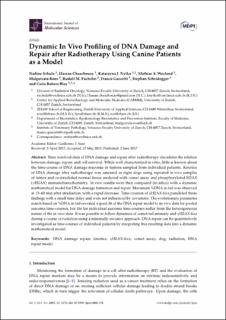Please use this identifier to cite or link to this item:
https://doi.org/10.21256/zhaw-1670| Publication type: | Article in scientific journal |
| Type of review: | Peer review (publication) |
| Title: | Dynamic in vivo profiling of DNA damage and repair after radiotherapy using canine patients as a model |
| Authors: | Schulz, Nadine Chaachouay, Hassan Nytko, Katarzyna J. Weyland, Mathias S. Roos, Malgorzata Füchslin, Rudolf Marcel Guscetti, Franco Scheidegger, Stephan Rohrer Bley, Carla |
| DOI: | 10.21256/zhaw-1670 10.3390/ijms18061176 |
| Published in: | International Journal of Molecular Sciences |
| Volume(Issue): | 18 |
| Issue: | 6/1176 |
| Issue Date: | 2017 |
| Publisher / Ed. Institution: | MDPI |
| ISSN: | 1422-0067 1661-6596 |
| Language: | English |
| Subjects: | Comet assay; Repair kinetics; Repair pathway model |
| Subject (DDC): | 572: Biochemistry |
| Abstract: | Time resolved data of DNA damage and repair after radiotherapy elucidates the relation between damage, repair, and cell survival. While well characterized in vitro, little is known about the time-course of DNA damage response in tumors sampled from individual patients. Kinetics of DNA damage after radiotherapy was assessed in eight dogs using repeated in vivo samples of tumor and co-irradiated normal tissue analyzed with comet assay and phosphorylated H2AX (γH2AX) immunohistochemistry. In vivo results were then compared (in silico) with a dynamic mathematical model for DNA damage formation and repair. Maximum %DNA in tail was observed at 15-60 min after irradiation, with a rapid decrease. Time-courses of γH2AX-foci paralleled these findings with a small time delay and were not influenced by covariates. The evolutionary parameter search based on %DNA in tail revealed a good fit of the DNA repair model to in vivo data for pooled sarcoma time-courses, but fits for individual sarcoma time-courses suffer from the heterogeneous nature of the in vivo data. It was possible to follow dynamics of comet tail intensity and γH2AX-foci during a course of radiation using a minimally invasive approach. DNA repair can be quantitatively investigated as time-courses of individual patients by integrating this resulting data into a dynamic mathematical model. |
| URI: | https://digitalcollection.zhaw.ch/handle/11475/2787 |
| Fulltext version: | Published version |
| License (according to publishing contract): | CC BY 4.0: Attribution 4.0 International |
| Departement: | School of Engineering |
| Organisational Unit: | Institute of Applied Mathematics and Physics (IAMP) |
| Appears in collections: | Publikationen School of Engineering |
Files in This Item:
| File | Description | Size | Format | |
|---|---|---|---|---|
| 2017_Schulz_Dynamic in vivo profiling_International Journal of Molecular Sciences.pdf | 2.16 MB | Adobe PDF |  View/Open |
Show full item record
Schulz, N., Chaachouay, H., Nytko, K. J., Weyland, M. S., Roos, M., Füchslin, R. M., Guscetti, F., Scheidegger, S., & Rohrer Bley, C. (2017). Dynamic in vivo profiling of DNA damage and repair after radiotherapy using canine patients as a model. International Journal of Molecular Sciences, 18(6/1176). https://doi.org/10.21256/zhaw-1670
Schulz, N. et al. (2017) ‘Dynamic in vivo profiling of DNA damage and repair after radiotherapy using canine patients as a model’, International Journal of Molecular Sciences, 18(6/1176). Available at: https://doi.org/10.21256/zhaw-1670.
N. Schulz et al., “Dynamic in vivo profiling of DNA damage and repair after radiotherapy using canine patients as a model,” International Journal of Molecular Sciences, vol. 18, no. 6/1176, 2017, doi: 10.21256/zhaw-1670.
SCHULZ, Nadine, Hassan CHAACHOUAY, Katarzyna J. NYTKO, Mathias S. WEYLAND, Malgorzata ROOS, Rudolf Marcel FÜCHSLIN, Franco GUSCETTI, Stephan SCHEIDEGGER und Carla ROHRER BLEY, 2017. Dynamic in vivo profiling of DNA damage and repair after radiotherapy using canine patients as a model. International Journal of Molecular Sciences. 2017. Bd. 18, Nr. 6/1176. DOI 10.21256/zhaw-1670
Schulz, Nadine, Hassan Chaachouay, Katarzyna J. Nytko, Mathias S. Weyland, Malgorzata Roos, Rudolf Marcel Füchslin, Franco Guscetti, Stephan Scheidegger, and Carla Rohrer Bley. 2017. “Dynamic in Vivo Profiling of DNA Damage and Repair after Radiotherapy Using Canine Patients as a Model.” International Journal of Molecular Sciences 18 (6/1176). https://doi.org/10.21256/zhaw-1670.
Schulz, Nadine, et al. “Dynamic in Vivo Profiling of DNA Damage and Repair after Radiotherapy Using Canine Patients as a Model.” International Journal of Molecular Sciences, vol. 18, no. 6/1176, 2017, https://doi.org/10.21256/zhaw-1670.
Items in DSpace are protected by copyright, with all rights reserved, unless otherwise indicated.